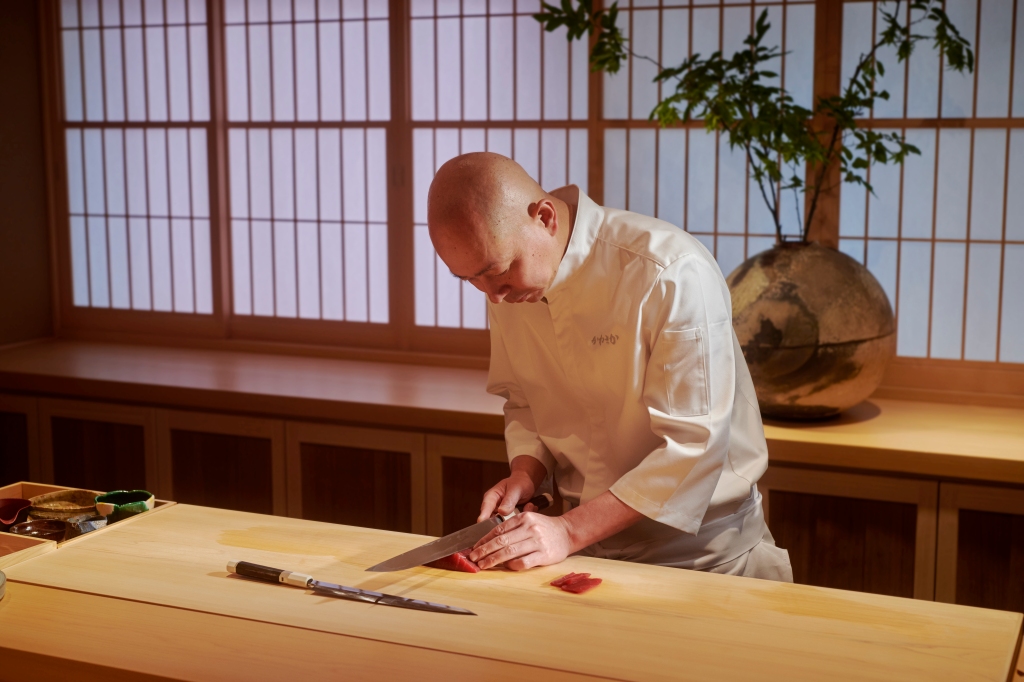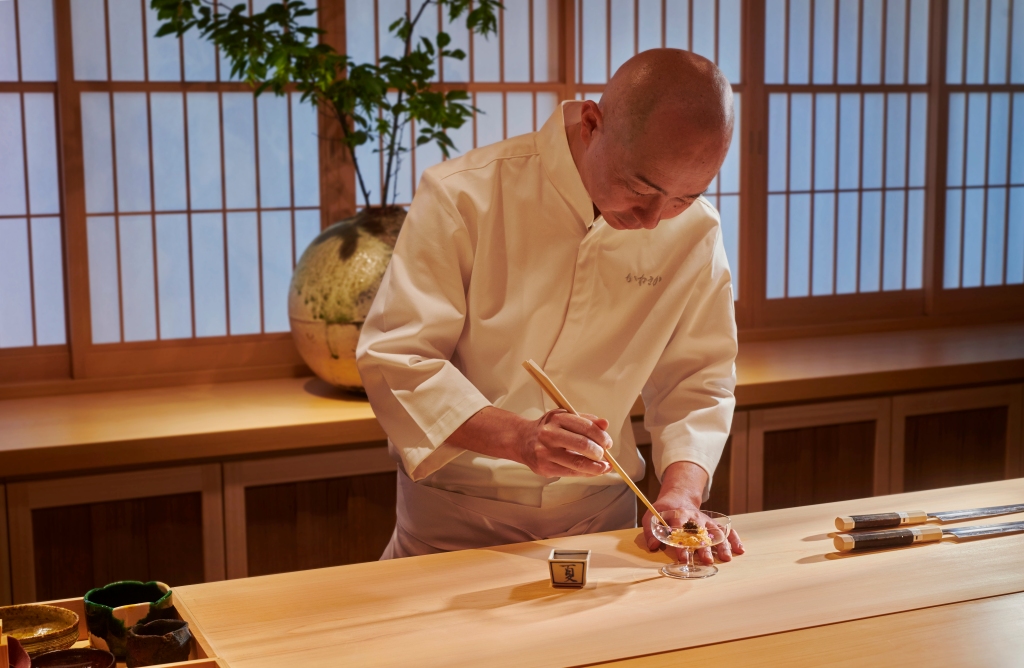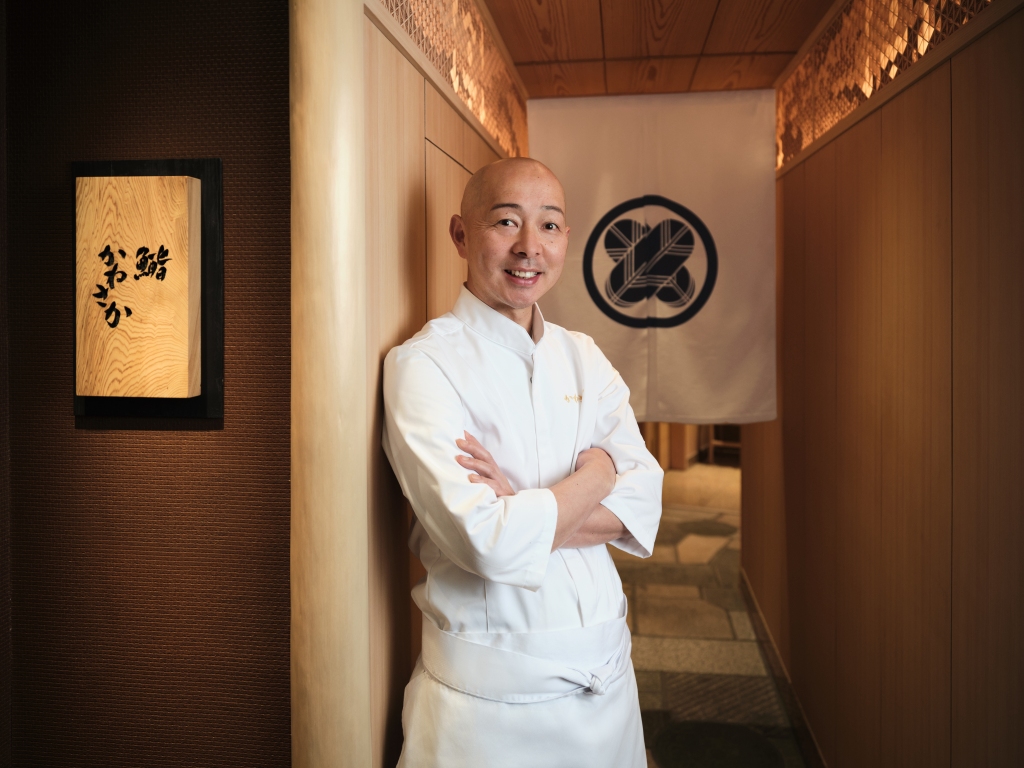A Little Slice of Tokyo comes to London’s Park Lane

I’m greeted by an elegant okami-san and led along a tiny but perfectly formed corridor of stone flooring flanked by cedar wood walls to beyond a noren where a counter is immaculately set up for dining. So far so Tokyo except I’m in London, tucked away on the first floor of the 45 Park Lane hotel.
This is Sushi Kanesaka the newest outpost from Japanese chef Shinji Kanesaka whose impressive restaurant empire spans several Michelin starred venues in Tokyo including his flagship two starred Ginza Sushi Kanesaka. He has also opened restaurants within five star hotels in Asia including at the Carlton and St Regis hotels in Singapore (which have one Michelin star apiece) and at the Palace Hotel, Tokyo.

Opening on July 1st Sushi Kanesaka at 45 Park Lane in Mayfair will be Kanesaka’s first restaurant outside Asia and I’m visiting during the soft launch for a preview. The London establishment seats just nine at the main counter as well as a further four in an adjacent private dining room. An omakase (“I’ll leave it up to you”) menu of around 18 courses will be offered at two dinner sittings from Tuesdays to Saturdays at the set price of £420. Perfectly paired sake to accompany the dishes will cost a further £150 to £220.
Up until now London’s most expensive set menu has been at The Araki (which also has a branch in Hong Kong) at £310 per head for the sushi omakase, according to UK restaurant guide Harden’s. And in its 2023 guide Harden’s decreed the most expensive in Britain to be at Ynyshir a restaurant with guest rooms in mid Wales serving a tasting menu with Japanese, Chinese and Thai influences cooked over fire at £375 per head. By this reckoning Sushi Kanesaka will now have the UK’s most expensive set menu.
Shinji Kanesaka trained under the legendary chef Takashi Saito of Sushi Saito in Tokyo and continues to follow his Edomae style of sushi using cured fish rather than raw for optimum flavour. Core ingredients such as wasabi and rice will be shipped in from Japan (Kanesaka has his own blend of rice from Yamagata prefecture) while fish will be sourced from Europe including the UK such as Cornish crab and Scottish lobster. All the fish will undergo the Japanese ikejime method to ensure the best quality.

From their seats at the counter – carved from a solid piece of hinoki wood as in Kanesaka’s other outlets – diners will be treated to the artful performance of the shokunin’s crafting dishes before each exquisite creation is carefully presented before them in succession. Mainly sushi as the restaurant name suggests but interspersed with steamed, grilled and fried dishes such as chawanmushi with fish soup, binchotan gilled kobe beef and ebifurai of lobster. And as is traditional with omakase, rounding off the savoury courses with a bowl of miso followed by seasonal Japanese fruits such as the most divine melon and mango from the Miyazaki prefecture.
Inside this calm oasis the stylishly simple décor of pale woods will be familiar to diners who’ve eaten at other Kanesaka establishments. A subtle reminder of the destination though is the woodwork panels featuring designs inspired by Hyde Park opposite the hotel on the other side of Park Lane.
The personable Kanesaka has been in London preparing with his team for the launch and will be in situ at the 45 Park Lane restaurant three to four times a year. The eight strong London team of chefs, sommeliers and hosts are mostly recruited from Kanesaka’s existing restaurants.

The sushi artisan says he’s chosen the British capital for his first restaurant in Europe as “London is recognised world over as the epicentre of high end dining”. He also points to the attraction of 45 Park Lane, and the Dorchester Collection of hotels which it belongs to , having a stable of internationally renowned chefs and Michelin starred restaurants. 45 Park Lane is already home to Cut by Wolfgang Puck – the US based celebrity chef’s first in Europe – while sister hotel next door, The Dorchester, houses the three Michelin starred restaurant Alain Ducasse.
While Kanesaka is opening his first outpost in Europe, the Dorchester Collection which also has hotels in Paris, Italy and Los Angeles has announced plans for its first hotel in Asia. Based within the Torch Tower in Tokyo, the tallest building in Japan with panoramic views of the bay, the city centre and Mount Fuji, the hotel is slated to open in 2028.







